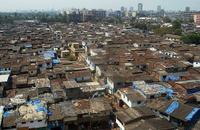
By Binu Alex
French, German and Spanish versions of this feature available
This is a World Council of Churches Feature from its World Social Forum(India) coverage
Free high resolution photos to accompany this feature are available here
The interaction lasted exactly two hours, but for some fifty young Christians who visited Dharavi, Asia's largest slum near Mumbai, the bonding will be forever. Beyond cold statistics, the slum is home to one million people, living in hundreds and thousands of shanties spread over 175 hectares. "Dharavi is the triumph of the human spirit over the struggle between need and survival," remarked a German youth delegate, Frank Joret. Joret, who is currently working with the Jeypoore Evangelical Lutheran Church, said that on his return home to Germany he will investigate how his church can help arrest the growth of slums, especially in third-world countries. But he was happy to see that the slum dwellers were all smiles, and warmly welcomed the group of young people, whose visit to Dharavi was arranged by the World Council of Churches (WCC), together with the National Council of Churches in India (NCCI), and the Student Christian Movement in India (SCMI). One of the WCC delegates from the US, Elizabeth Constable, said she and her friends bowed in the slums. "We bowed to get into their houses. The living conditions were apalling. Little better than the sewers," she said.But for Dharavi residents, this is a fact of life. K. M. Ranganathan is a 65-year-old Dharavi resident. His 12 x 40-feet room at Dharavi has seven residents. "We have divided it into four rooms for four families," Ranganathan said. Built on open marshy land some fifty years ago, Dharavi now has dwellings that, by slum standards, are high class. Some, like that of Ranganathan, are three-floor structures with floors that are rented out.Where Ranganathan lives, the entire chawl (narrow lane) has six toilets serving more than 500 people. "It is difficult, but there is no alternative," Ranganathan said. The ecumenical youth delegates attending the World Social Forum strongly believe that there are alternatives. As for Shashikant Jhadav, a Mumbai taxi driver who is another "proud resident" of Dharavi, when asked about another world, he answered that it "may be possible, but we will remain where we are. Perhaps it will even worsen."The young visitors from the WCC, Churches Auxiliary for Social Action, the NCCI and the Young Men's & Young Women's Christian Associations were stunned by what they saw.Dharavi epitomizes the squalor of Mumbai's teeming millions living in the shadow of the luxurious skyscrapers of the few rich. Sandwiched between the western and central suburban railway lines, it is often seen as an insult to the city, and described as a breeding ground for criminals.From electric wiring to telephones to water lines, everything is tolerated in Dharavi; the government has accepted that its occupants are no longer "illegal", even though they have no official legal status."Thank God, it's not the rainy season," SCMI representative Ritesh Marandi said with relief. During the monsoon, trains don't run, and streets are under water. Dharavi is worse. Sewage and rainwater gets mixed and, in many cases, the houses collapse.Children with their uncombed hair and tattered clothes surrounded the delegates, little hands reaching out to touch. "We were touched emotionally. In the midst of the worst living conditions, they looked happier than the luxurious car owners," Marandi recollected.But then, if they are happy, why should their lives be changed? "Because they don't live their lives. They simply survive. Even animals do that. What is the difference between the two? They smile because they can't cry and survive," Marandi was quick to respond.The Dharavi residents are able to get water and electricity, even if the government turns off the taps and the Bombay Electric Supply & Transport Company cuts off their illegal hook-ups. More importantly, they have found a rhythm of survival. And although people from various regions and religions live all jammed together in what could be considered intolerable proximity, no sectarian violence has been reported from Dharavi. Efforts by the Community Outreach Programme (CORP) volunteers have not made much headway in the slum. Dharavi continues to grow day by day as migrants find no other place to live. Many of the young visitors judged that the slum's growth is directly related to way state policies deal with the urban poor."It is sad, but what we need to address is how to halt the increase in the numbers of poor people. I hope you will all keep what you have seen in mind when you participate in the World Social Forum," Dinesh Suna, the NCCI youth secretary, concluded.
No comments:
Post a Comment